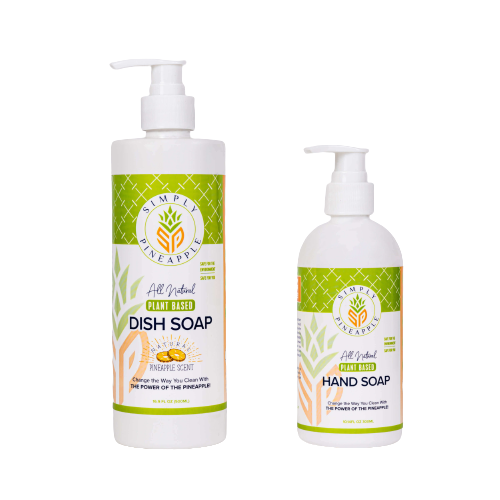Ingredients
Simply Pineapple’s Enzyme
Ingredients: Water, pineapple peels, locally sourced sugar
Description: Simply Pineapple’s enzyme is packed with enzymes including bromelain. These enzymes act as little helpers that break down complex stains and proteins. Our pineapple enzyme is acidic and has a slightly sour smell and taste in its natural form. The acidic nature of the enzyme also helps to neutralize odors and disrupt the cell membranes of many bacteria and microorganisms.
Found in: Liquid Hand Soap, Liquid Dish Soap.
Soapberry
Description: Soapberries, also known as soap nuts or Sapindus berries, are natural cleaning agents that have been used for centuries in various parts of the world. They contain natural saponins, which are surfactant compounds that can clean and remove dirt, grime, and stains. Surfactants are molecules that can lower the surface tension of water, allowing it to spread and penetrate more effectively. Saponins are particularly good at this because they have a hydrophilic (water-attracting) head and a hydrophobic (water-repelling) tail.
Found in: Liquid Hand Soap, Liquid Dish Soap.
Cocamidopropyl Betaine
Description: Derived from coconut oil, cocamidopropyl betaine is a mild fatty acid surfactant that improves cleansing and foaming. Cocamidopropyl betaine lowers the surface tension of water, making it easier for the cleaning solution to spread and penetrate surfaces. This helps the cleaning agent to cover a larger area and access hidden dirt and grime. Cocamidopropyl betaine is often chosen for cleaning agents and personal care products because it is mild and less likely to cause skin or eye irritation compared to some other surfactants. It contributes to the overall mildness of a cleaning product, making it suitable for sensitive skin and delicate surfaces.
Found in: Liquid Hand Soap, Liquid Dish Soap.
Decyl Glucoside
Description: Derived from coconut, decyl glucoside is a gentle, non-toxic, non-ionic surfactant that’s often used in natural products, including baby shampoos and products for sensitive skin. Decyl glucoside lowers the surface tension of water, making it easier for the cleaning solution to spread and penetrate surfaces. Decyl glucoside can help emulsify oils and greases, which means it can break them down into tiny droplets that can be dispersed in water. This is particularly useful for cleaning agents that need to remove oily or greasy residues.
Found in: Liquid Hand Soap, Liquid Dish Soap.
Glycerin
Description: Glycerin is well-known for its moisturizing and humectant properties. In a cleaning formula, glycerin helps prevent the formula from drying out or evaporating too quickly. Glycerin is gentle on the skin and can provide a protective barrier when used in cleaning products that come into contact with the skin. It helps prevent excessive drying or irritation, making the product more suitable for frequent use.
Found in: Liquid Hand Soap, Liquid Dish Soap.
Baking Soda (Sodium Bicarbonate)
Description: Baking soda is a versatile and widely used ingredient in cleaning formulas. It acts in several ways to help clean and freshen surfaces effectively. Baking soda is a mild abrasive, acts as a natural deodorizer, assists with removing certain types of stains, stabilizes pH, and is biodegradable.
Found in: Liquid Hand Soap, Liquid Dish Soap.
Potassium Sorbate
Description: Potassium sorbate is a common preservative used widely in personal care products as well as many of the items you see in your grocery store. These include bottled water, baked goods, dairy products, dressings, canned and packaged foods, personal care products, etc. Its primary function in a hand soap formula is to prevent the growth of mold, yeast and bacteria, thereby extending the shelf life and maintaining the safety and quality of the product.
Found in: Liquid Hand Soap, Liquid Dish Soap.
Olive Oil
Description: Olive oil is rich in natural fats and emollients, such as oleic acid and squalene. These components are excellent for skin hydration. When incorporated into a hand soap, olive oil helps to prevent the soap from drying out the skin excessively. It acts as a moisturizer, leaving your hands feeling softer and less prone to dryness or irritation after washing. Olive oil contains antioxidants, such as vitamin E and polyphenols. These compounds help protect the skin from environmental damage and oxidative stress. When used in hand soap, they contribute to maintaining the overall health and appearance of your skin.
Found in: Liquid Hand Soap.
Tangerine Essential Oil
Description: Tangerine essential oil contains compounds like limonene and alpha-pinene, which may have mild antibacterial and antifungal properties. When used in a hand soap formula, it can contribute to cleaning and purifying the skin. Additionally, the oil may help soothe dry or irritated skin due to its moisturizing properties. Tangerine essential oil contains antioxidants, such as vitamin C and carotenoids, which can help protect the skin from environmental damage and oxidative stress. These antioxidants may promote healthier-looking skin and contribute to its overall well-being.
Found in: Liquid Hand Soap.
Sodium Coco Sulfate
Description: Sodium coco sulfate is derived from coconut and is a surfactant commonly used in liquid dish soap formulas. It is a sustainable alternative to products extracted from palm oil. One of the primary functions of sodium coco sulfate in dish soap is to lower the surface tension of water. Water molecules naturally have a strong tendency to stick together, creating surface tension. This surface tension makes it difficult for water to spread out and effectively penetrate and clean greasy and oily residues on dishes. Sodium coco sulfate is derived from coconut oil and is generally considered biodegradable and environmentally friendly. It breaks down in the environment more readily than some other surfactants, reducing its impact on aquatic ecosystems when the soap is washed down the drain.
Found in: Liquid Dish Soap.

